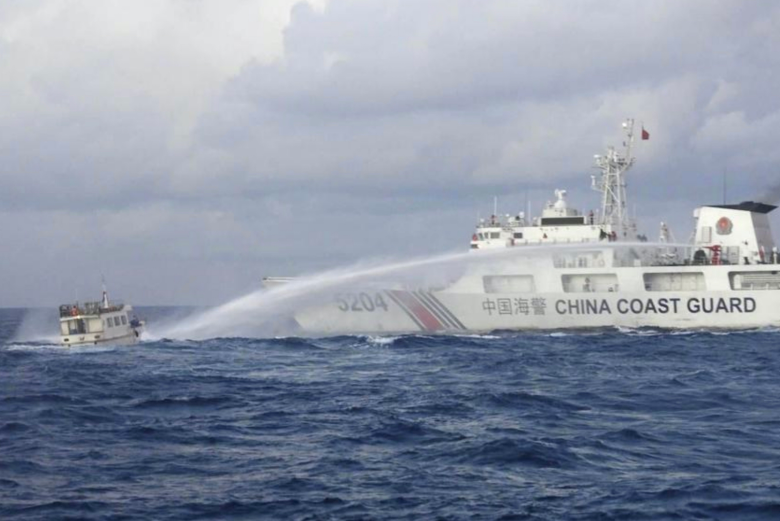During the past weekend, Beijing was charged by Manila with the attempt to construct an “artificial island” at Sabina Shoal, a vacant reef located 75 nautical miles away from the island of Palawan. The Philippines announced yesterday that it plans to strengthen its presence in the South China Sea’s shoals and islets to deter China from performing land reclamation operations on disputed territories.
This assertion follows the disclosure by the Philippine Coast Guard (PCG) that it had dispatched a vessel to the uninhabited Sabina Shoal “to keep an eye on the alleged unlawful activities of China, which involves the creation of ‘an artificial island’” on the underwater reefs, as per a statement issued by the office of President Ferdinand Marcos Jr.
Commodore Jay Tarriela, the spokesperson for the PCG, informed a media forum on Saturday that there had been a “minor reclamation” at Sabina Shoal, with China being the “most likely perpetrator.” He mentioned that the coast guard had found heaps of dead and pulverized coral that had been discarded on the shoal’s sandbars, which Manila calls Escoda Shoal. “It’s been noticed that pulverized corals were discarded, and it’s highly probable that the marine characteristics were modified,” Tarriela stated in a distinct post on X (previously known as Twitter).
Recently, at a forum in Manila, Tarriela made a statement. The agency, he said, is determined to maintain its presence in the region. The goal? To thwart China’s attempts at successful reclamation in Sabina Shoal. Flashback to the mid-2010s, China managed to execute a large-scale land reclamation in the Spratly Islands, transforming some of them into man-made islands. These islands are now equipped with airstrips, radar systems, and government buildings. The agency’s commitment is to ensure history does not repeat itself at Sabina Shoal.
Manila is highly motivated to stop China from transforming Sabina Shoal into an island stronghold akin to its other territories. The shoal is strategically located to the east of China’s seven other features in the Spratly Islands, a mere 75 nautical miles off the coast of Palawan, the westernmost island of the Philippines. Additionally, Sabina Shoal serves as a meeting point for ships on resupply missions to Second Thomas Shoal. This submerged reef, occupied by the Philippines and situated about 36 nautical miles to the west, has emerged as a major hotspot in the China-Philippines dispute.
In the last year and a half, the China Coast Guard (CCG) has escalated its efforts to obstruct the Philippines’ resupply missions to its forces at Second Thomas Shoal, where they are based on a beached warship. In recent confrontations, the CCG has resorted to ramming and using high-pressure water cannons against PCG vessels and supply boats commissioned by the Philippine Navy, inflicting significant damage. This has led to a diplomatic row, with both sides regularly accusing each other of duplicity and dishonesty, and no apparent resolution in sight.
Sure enough, China’s Foreign Ministry denied the claim that it had begun reclamation at Sabina Shoal, dismissing the accusation as “groundless and pure rumor.”
“Of late, the Philippines has been persistently circulating rumors, intentionally defaming China, and trying to misguide the global community, all in vain,” spokesperson Wang Wenbin stated at a press conference in Beijing. He called on the nation to “realign its approach towards resolving maritime disputes through dialogue and mutual consultation.
As the strain escalates, the Philippines has announced its intention to broaden its watchfulness to all 11 features it holds in the Spratly Islands, along with several other unoccupied features like Sabina Shoal within its Exclusive Economic Zone (EEZ). In related news, Jonathan Malaya, the spokesperson for the National Security Council (NSC), revealed yesterday that NSC head Eduardo Año has instructed for increased security at locations within Manila’s EEZ, as reported by Reuters.
“Only we will stand guard over these locations,” Malaya declared during a TV interview. “Under international law, it’s our duty to protect these areas, ensure their environment remains unharmed, and prevent any reclamation activities.” These remarks were made on the same day the Philippines disclosed its plans to initiate a formal probe into claims that staff at the Chinese embassy in Manila had been involved in spreading misinformation pertaining to the South China Sea conflicts.
The focal point of the investigation will be a recording, unveiled by the embassy just last week. This recording allegedly captures an exchange between an unidentified Chinese diplomat and Vice Admiral Alberto Carlos of the Philippines, the head of the Western Command of the Armed Forces based in Palawan. The conversation pertains to the handling of the escalating tensions at Second Thomas Shoal. The release of this recording was strategically timed to bolster China’s assertion that the Philippines had initiated an informal pact aimed at diffusing the heated situation at the shoal.
Late last week, NSA chief Año urged the government to expel the Chinese embassy staffers for allegedly recording a phone conversation, in possible breach of the Philippine law. The Department of Foreign Affairs subsequently said it would “look into any reports of illegal and unlawful activities by diplomatic officials, and undertake necessary action in line with existing laws and regulations.”

Leave a Reply